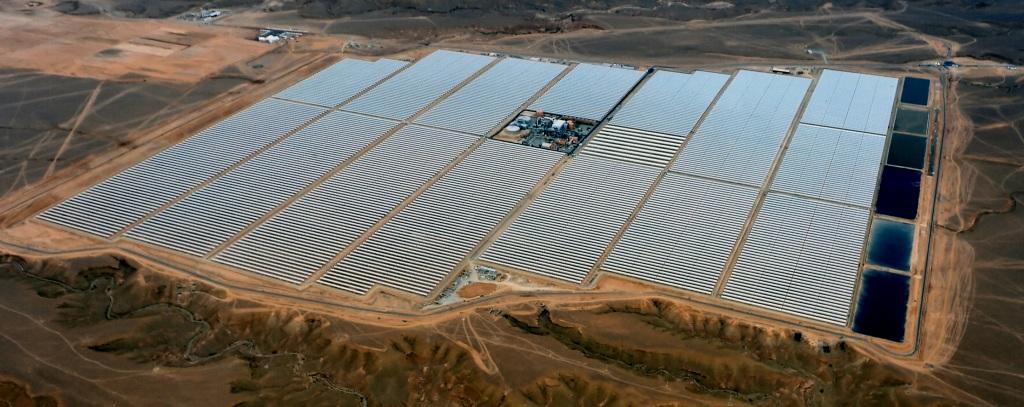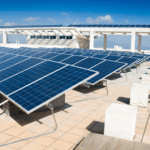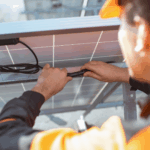
This article has been updated on 10/04/2024
As of October 2024, China, United Arab Emirates, and India have taken over as the leading developers of large-scale solar power projects.
U.S. demand for solar power is surging despite an economic recession, thanks to government financial incentives, some easing in credit availability, and increasing public recognition of its environmental benefits.
Although the largest utility-scale plants are outside the United States, the USA plays a significant role in residential and commercial solar development.
Table of Contents
Largest Solar Power Plants as of 2024
1. Gonghe Talatan Solar Park

Location: Located in Qinghai Province, China, Gonghe County is known for its favorable geographic and climatic conditions for solar power generation.
Capacity: 15,600 megawatts (MW)
2. Hobq Solar Park, China
- Capacity: 4,000 MW (4 GW)
- Annual Output: 133 MW
- Completion: 2024
- Additional Notes:
- The park is spread across two separate areas, Hanggin Banner and Dalad Banner, each contributing 2 GW.
- Dalad Banner has future plans for expansion up to 13.5 GW, which would make it a significant contributor to China’s energy grid.
3. Otog Front Banner Solar Park, China
- Capacity: 4,000 MW (4 GW)
- Area: 5,700 km²
- Annual Output: 90 MW
- Completion: 2024
- Additional Notes: 3 GW of capacity is owned by China Energy Group, while 1 GW is owned by Inner Mongolia Energy Group.
4. Midong Solar Park, China
- Capacity: 3,500 MW (3.5 GW)
- Area: 6,090 km²
- Annual Output: 133 MW
- Completion: 2024
- Additional Notes: Largest single PV station in China, demonstrating the scale and efficiency of centralized solar installations.
5. Bhadla Solar Park – 2245MW – India

Location: Bhadla, Rajasthan, India
Capacity: Approximately 2,245 megawatts (MW)
Features: Spread over 14,000 acres, Bhadla Solar Park is the most extensive solar array in the world. Its arid and sunny location makes it ideal for solar power generation. The park plays a crucial role in India’s ambitious renewable energy targets.
6. Pavagada Solar Park

Location: Pavagada, Karnataka, India
Capacity: Nearly 2,050 MW
Features: Pavagada Solar Park’s development was innovative, using a land-leasing model from local farmers. This approach minimized displacement and land acquisition issues, setting a precedent for future projects.
7. Mohammed bin Rashid Al Maktoum Solar Park

Location: Situated in Dubai, the Mohammed bin Rashid Al Maktoum Solar Park is strategically located to harness the abundant sunshine of the desert region.
Capacity and Scale: 2027 megawatts (MW). The park’s planned capacity is set to reach around 5,000 megawatts (MW) by 2030. This makes it one of the largest solar parks in the world in terms of total capacity.
Phases of Development: The park is being developed in multiple phases. Each phase involves the introduction of new technologies and an increase in capacity.
8. Al Dhafra Solar PV

Location: The project is in the Al Dhafra region, near Abu Dhabi, UAE. This region is characterized by abundant sunlight, making it an ideal location for solar energy production.
Capacity and Size: As of 2023, the Al Dhafra Solar PV project was planned to have a capacity of approximately 2 gigawatts (GW), which positions it among the world’s largest single-site solar photovoltaic (PV) projects.
Largest Solar Plants in the United States
Edwards Sanborn Solar and Energy Storage Project, California

- Capacity: 875 megawatts (MW).
- Highlight: Currently holds the title as the largest solar farm in the USA.
- Impact: This massive project significantly contributes to California’s renewable energy goals.
Copper Mountain Solar Power Plant, Nevada

- Capacity: 802 megawatts (MW).
- Location: Situated in Boulder City, Nevada, this plant is one of the country’s most substantial solar installations.
- Innovation: Features advanced solar technologies that enhance its energy production efficiency.
Desert Sunlight Solar Power Plant, California

- Capacity: 550 megawatts (MW).
- Impact: Powers approximately 160,000 homes, playing a crucial role in California’s clean energy supply.
- Technology: Utilizes photovoltaic technology to convert sunlight into electricity efficiently.
Solar Star Solar Power Plant, California

- Capacity: 579 megawatts (MW).
- Innovation: Known for its single-axis tracker system, increasing energy production by 25% compared to stationary panels.
- Impact: Generates enough energy to power nearly 255,000 homes in Kern and Los Angeles Counties.
Spotsylvania Solar Power Plant, Virginia

- Capacity: 618 megawatts (MW).
- Location: Located in Spotsylvania County, Virginia, this plant significantly contributes to the East Coast’s renewable energy portfolio.
- Ownership: A joint venture involving NextEra Energy Resources, NRG Yield Operating, and Sumitomo Corporation of America.
Previous Largest Solar Sites as of 2019
Kamuthi Solar Power Project – 648MW – India

The facility in Kamuthi, Tamil Nadu, has a capacity of 648 megawatts and covers an area of 10 kilometres squares. This makes it the largest solar power plant at a single location, taking the title from the Topaz Solar Farm in California, which has a capacity of 550 MW.
http://www.businessinsider.com/india-has-built-the-worlds-largest-solar-power-plant-2016-11
Longyangxia Dam Solar Park – 850MW – China

The Longyangxia Dam Solar Park is China’s latest in a long line of large-scale solar energy projects. A solar farm in the city of Cixi in eastern Zhejiang province made the news recently for installing 300 hectares of solar panels above a fish farm. The farm is expected to generate 220 gigawatt hours of electricity a year – enough power for 100,000 households – according to the state-run Xinhua news agency.
https://visibleearth.nasa.gov/view.php?id=89668
Kurnool Ultra Mega Solar Park – 1000 MW – India

With 900 MW of the 1,000 MW already commissioned at the Kurnool Ultra Solar Park, and the remaining to be fully operational next month, it has already become the largest such park outpacing 648 MW solar park developed by Adani in Tamil Nadu and Topaz Solar Park of 550 MW in California.
Datong Solar Power Top Runner Base – 1000MW – China

With 1GW Phase I completed and a Total capacity of 3GW in 3 phases. Datong Solar Power plant in China has the potential to be the largest solar plant in the world once completed. According to government statistics, from July 2016 to January 2017, Datong generated a total of 870 million watts of electricity, equivalent to more than 120 million watts per month of power generation.
https://en.wikipedia.org/wiki/List_of_photovoltaic_power_stations
Noor Solar Park – 1117MW – Morocco

Ouarzazate Solar Power Station (OSPS), also called Noor Power Station, is a solar power complex located in the Drâa-Tafilalet region in Morocco, 10 kilometers (6.2 mi) from Ouarzazate town, in Ghessat rural council area. At 1117 MW, it is the world’s largest concentrated solar power plant. With an additional 72 MW photovoltaic system, the project is planned to produce 1117 MW at peak when finished and is being built in three phases and four parts. The total project is expected to cost $9 billion.
Pavagada Solar Park – 1400MW – India

Pavagada solar park is a 2GW solar complex being developed in Pavagada, Tumkur district, approximately 180km from Bengaluru, Karnataka, India. It is expected to become the world’s biggest solar farm when completed.
Tengger Desert Solar Park – 1500MW – China

The 1547MW solar power plant in Zhongwei, Ningxia, is the world’s largest solar array. Known as the “Great Wall of Solar” in China. The Tengger Desert is an arid natural region that covers about 36,700 km and is mostly in China’s Inner Mongolia Autonomous Region. The solar field itself covers 1,200 Km (3.2%) of land.
Previous Largest Sites as of 2009
Arnedo Solar Plant, Spain
The plant produces an impressive 34 GWh every year, which will power 12,000 households and prevent 375,000 tonnes of CO2. The facility sits on seventy hectares and houses 172,000 panels. The project’s budget was around €180,000,000. La Rioja, a Spanish region known for its wine, already covers 62% of its electricity with renewable sources.

Waldpolenz Solar Park, Germany

Waldpolenz Solar Park, the world’s largest thin-film photovoltaic (PV) power system, is built on a military air base to the east of Leipzig in Germany. The power plant is a 40-megawatt solar power system using state-of-the-art thin film technology. 550,000 First Solar thin-film modules are used, which supply 40,000 MWh of electricity per year. The investment cost for the Waldpolenz solar park amounts to some Euro 130 million.
Moura Photovoltaic Power Station, Portugal
The Moura photovoltaic power station is located in the municipality of Moura, in Alentejo, Portugal, one of the sunniest regions in Europe and one of the most economically depressed. Its construction involves two stages, with the first one being constructed in 13 months and completed in 2008, and the other will be completed by 2010, at a total cost of €250 million for the project.
The power station will have an installed capacity of 46 MWp, counting over 376,000 solar panels. Almost 190,000 panels (32 MW) are fitted on fixed structures, 52,000 (10 MW) on single-axis trackers, which follow the sun across the sky, and a further 20 MW of power capacity will be added during phase two of the project. It will occupy an area of 320 acres (130 hectares), producing 88 GWh of electrical energy per year.
Puertollano Photovoltaic Park, Spain
Renovalia developed this power station in Puertollano, Ciudad Real, housing an energy park with an installed 50 megawatts (MW) capacity. The power generated here is equivalent to the annual domestic electricity consumption of about 39,000 households. The energy produced here will replace a theoretical discharge of 84,000 tons of CO2/year or 2.1 million tons of CO2 over the 25 years during its production.
Olmedilla Photovoltaic Park, Spain

The Olmedilla Photovoltaic (PV) Park uses 162,000 flat solar photovoltaic panels to deliver 60 megawatts of electricity on a sunny day. The entire plant was completed in 15 months at a cost of about $530 million at current exchange rates. Olmedilla was built with conventional solar panels, made with silicon and tend to be heavy and expensive.
Rancho Cielo Solar Farm, USA
The Rancho Cielo Solar Farm is the largest proposed solar farm in the United States. It is located in an industrial community in Belen, New Mexico, named Rancho Cielo, and is expected to provide the majority of the community’s power when it is completed. It’s cost expectation is $840 million, and it will provide 600 MWp, and will cover an area of 700 acres (280 ha). The solar farm will use thin film silicon panels built locally.
Topaz Solar Farm, USA
Topaz Solar Farm is a proposed 550 megawatt (MW) solar photovoltaic power plant, to be built by First Solar, Inc. (thin film silicon solar module maker) in the Carrizo Plain, northwest of California Valley at a cost of over $1 billion. On August 14, 2008, Pacific Gas and Electric announced an agreement to buy all the power from the power plant.


